Description
Prefabricated Bridge Elements and Systems (PBES) Definitions
Prefabricated Bridge Elements and Systems (PBES):
Use of prefabricated bridge elements and systems (PBES) is one strategy that can meet the objectives of accelerated bridge construction. PBES are structural components of a bridge that are built offsite, or near-site of a bridge, and include features that reduce the onsite construction time and mobility impact time that occur from conventional construction methods. PBES includes innovations in design and high-performance materials and can be combined with the use of "Fast Track Contracting" methods. Because PBES are built off the critical path and under controlled environmental conditions, improvements in safety, quality, and long-term durability can be better achieved.
Elements:
Prefabricated elements are a category of PBES which comprise a single structural component of a bridge. Under the context of ABC, prefabricated elements reduce or eliminate the onsite construction time that is needed to build a similar structural component using conventional construction methods. An element is typically built in a prefabricated and repeatable manner to offset costs. Because the elements are built under controlled environmental conditions, the influence of weather related impacts can be eliminated and improvements in product quality and long-term durability can be better achieved.
- Deck Elements
Prefabricated deck elements eliminate activities that are associated with conventional deck construction, which typically includes onsite installation of deck forms, overhang bracket and formwork installation, reinforcing steel placement, paving equipment set up, concrete placement, and concrete curing, all typically occurring in a sequential manner.
Examples of Deck Elements include:
- partial-depth precast deck panels
- full-depth precast deck panels with and without longitudinal post-tensioning
- lightweight precast deck panels
- FRP deck panels
- steel grid (open or filled with concrete)
- orthotropic deck
- other prefabricated deck panels made with different materials or processes
- Beam Elements
Prefabricated beam elements are composed of two types: "deck" beam elements" and "full-width" beam elements.
- Deck beam elements eliminate conventional onsite deck forming activities as noted above. To reduce onsite deck forming operations, deck beam elements are typically placed in an abutting manner.
Examples of Deck Beam Elements include:
- adjacent deck bulb tee beams
- adjacent double tee beams
- adjacent inverted tee beams
- adjacent box beams
- modular beams with decks
- post-tensioned concrete thru beams
- other prefabricated adjacent beam elements
Note: Although not preferred under the context of ABC, a separate construction phase (performed in an accelerated manner) may be required to finish the deck. A deck connection closure pour, overlay, or milling operation using innovative materials can be used to expedite the completion of the deck. In some situations, the placement of overlays can be accomplished during off-peak hours after the bridge is opened to traffic.
- Full-width beam elements eliminate conventional onsite beam placement activities. They are typically rolled, slid, or lifted into place to allow deck placement operations to begin immediately after placement. Given their size and weight, the entire deck is not included.
Examples of Full-Width Beam Elements include:
- truss span without deck
- arch span without deck
- other prefabricated full-width beam element without deck
- Deck beam elements eliminate conventional onsite deck forming activities as noted above. To reduce onsite deck forming operations, deck beam elements are typically placed in an abutting manner.
- Pier Elements
Prefabricated pier elements eliminate activities that are associated with conventional pier construction, which typically includes onsite form installation, reinforcing steel placement, concrete placement, and concrete curing, all typically occurring in a sequential manner.
Examples of Pier Elements include:
- prefabricated caps for caisson or pile foundations
- precast spread footings
- prefabricated columns
- prefabricated column caps
- prefabricated combined caps and columns
- other prefabricated pier elements
- Abutment and Wall Elements
Prefabricated abutment and wall elements eliminate activities that are associated with conventional abutment and wall construction, which typically includes form installation, reinforcing steel placement, concrete placement, and concrete curing, all occurring in a sequential manner.
Prefabricated abutment and wall elements may be built in a phased manner using conventional construction methods, but under or near an existing bridge without disrupting traffic
Examples of Abutment and Wall Elements include:
- prefabricated caps for caisson or pile foundations
- precast footings, wing walls, or backwalls
- sheet piling (steel or precast concrete)
- prefabricated full height wall panels used in front, behind, or around foundation elements
- cast-in-place concrete abutments and walls used with or without precast elements if built in a manner that is accelerated, or has no impact to mobility
- MSE, modular block, or proprietary walls; ABC walls are included under the "Geotechnical Solutions" area of ABC
- Geosynthetic Reinforced Soil (GRS) abutment; see "Geotechnical Solutions"
- Other prefabricated abutment or wall elements
- Miscellaneous Elements
Prefabricated miscellaneous elements either eliminate various activities that are associated with conventional bridge construction or compliment the use of PBES.
Examples of Miscellaneous Elements include:
- precast approach slabs
- prefabricated parapets
- deck closure joints
- overlays
Includes overlays that can be placed in an accelerated manner that complements or enhances the durability and rideability of the prefabricated element
- other prefabricated miscellaneous elements
Note: Any cast-in-place concrete or overlay placement operation should be performed in a manner that reduces the impacts to mobility. This may require work that is performed under "Fast Track Contracting" methods with incentive/disincentive clauses, nighttime or off-peak hour timeframes, or work done entirely off line. Innovative materials may be needed to expedite placement times such as the use of rapid-set/early-strength-gain materials or ultra-high-performance concrete (UHPC) in closure pours.
Systems
Prefabricated Systems are a category of PBES that consists of an entire superstructure, an entire superstructure and substructure, or a total bridge that is procured in a modular manner such that traffic operations can be allowed to resume after placement. Prefabricated systems are rolled, launched, slid, lifted, or otherwise transported into place, having the deck and preferably the parapets in place such that no separate construction phase is required after placement. Due to the manner in which they are installed, prefabricated systems often require innovations in planning, engineering design, high-performance materials, and "Structural Placement Methods".
Benefits of using prefabricated systems include:
- Minimal utility relocation and right-of-way take (if any at all)
- No- to- minimal traffic detouring over an extended period of time
- Preservation of existing roadway alignment
- No use of temporary alignments
- No temporary bridge structures
- No- to- minimal traffic phasing or staging
- Superstructure Systems: Superstructure systems include both the deck and primary supporting members integrated in a modular manner such that mobility disruptions occur only as a result of the system being placed. These systems can be rolled, launched, slid, lifted, or transported in place, onto existing or new substructures (abutments and/or piers) that have been built in a manner that does not impact mobility.
Examples of Superstructure Systems include:
- full-width beam span with deck
- through-girder span with deck
- truss span with deck
- arch span with deck
- other prefabricated superstructure systems
- Superstructure/Substructure Systems: Prefabricated superstructure/substructure systems include either the interior piers or abutments which are integrated in a modular manner with the superstructure as described above. Superstructure/substructure systems can be slid, lifted, or transported into place onto new or existing substructures that have been built in a manner that does not impact mobility.
Examples of Superstructure/Pier Systems include:
- rigid frames with decks and parapets
- other prefabricated superstructure/pier systems
Examples
The following pages contain examples of common prefabricated bridge elements and systems:
| Deck Elements | Examples |
|---|---|
| Partial-depth precast deck panels | 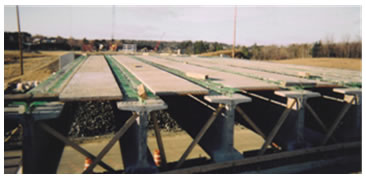 |
Full-depth precast deck panels with and without longitudinal post-tensioning Lightweight precast deck panels |
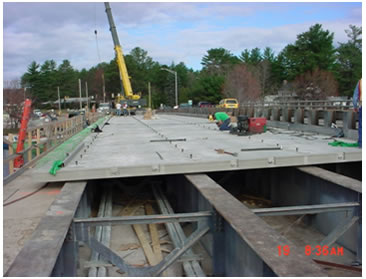
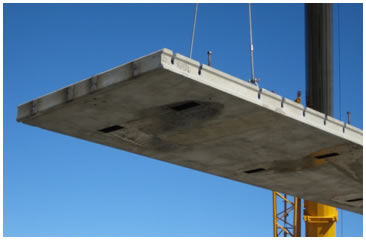 |
| FRP deck panels | 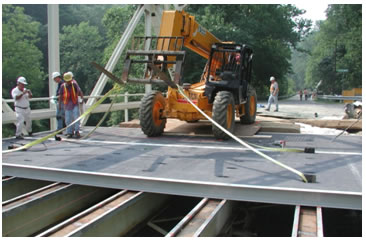 |
| Steel grid (open or filled with concrete) | 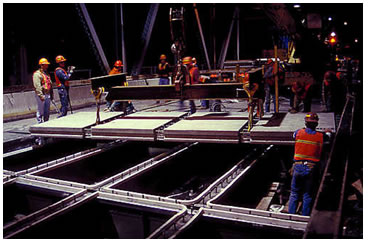 |
Orthotropic deck | 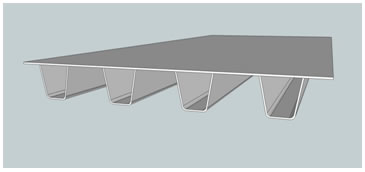 |
Adjacent deck bulb tee beams | 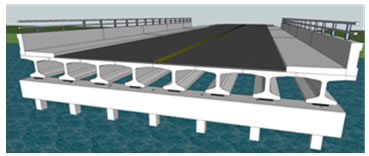 |
Adjacent double tee beams |
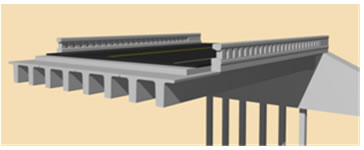 |
| Adjacent inverted tee beams | 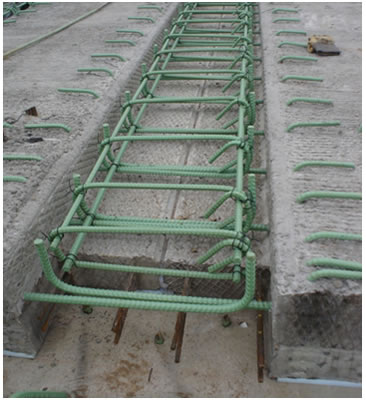 |
| Adjacent box beams | 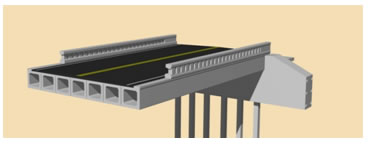 |
| Modular beams with decks | 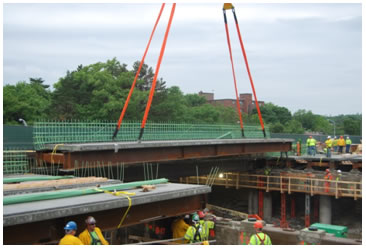 |
| Truss span without deck | |
| Arch span without deck | 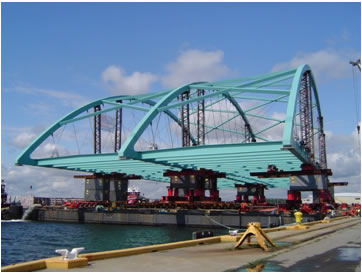 |
| Prefabricated caps for caisson or pile foundations | 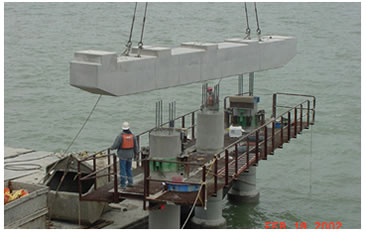 |
Precast spread footings |
 |
Prefabricated combined caps and columns |

